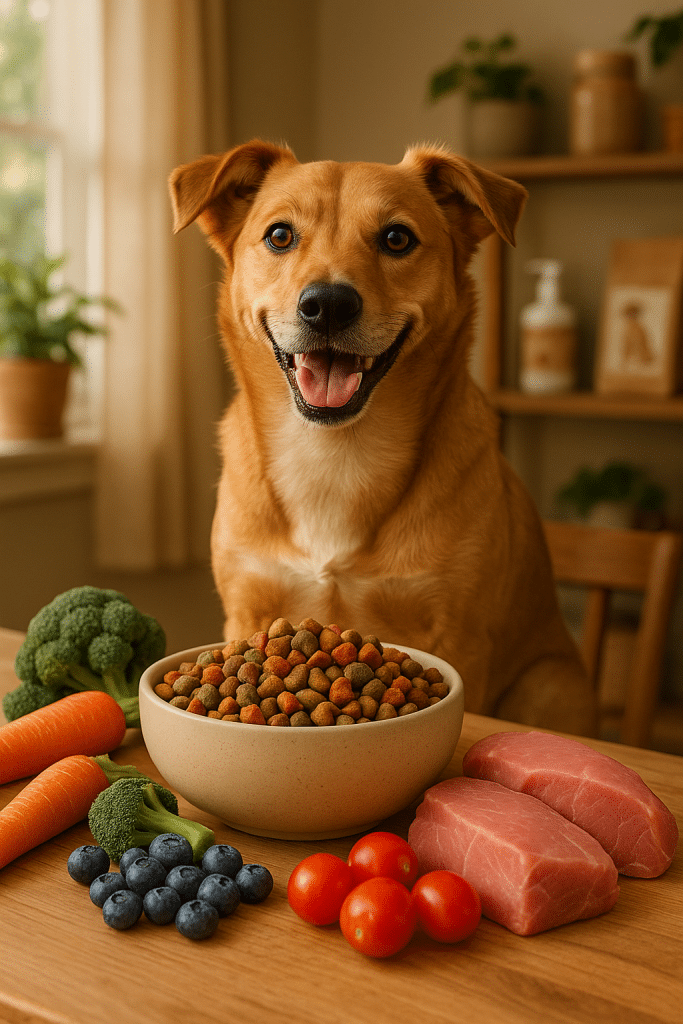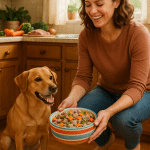As a devoted pet owner, I know how important it is to make informed choices about what goes into your dog’s bowl. With increasing options in the pet food aisle, “grain free dog food” has become a buzzword that many of us either swear by or question. You’ve probably asked yourself: Is grain free dog food really better for my dog? Which brands are trustworthy? How do I transition without upsetting my furry friend’s tummy? This article is here to demystify grain free dog food by sharing seven essential facts tailored specifically for pet owners like you. We’ll explore what grain free means, the health implications, how to choose and transition to these diets, and even review top grain free products on the market today.
Whether your dog has allergies, a sensitive stomach, or you’re just aiming for the best nutrition possible, understanding grain free diets will empower you to make confident choices—and your dog will thank you for it. Let’s dig into the details and insights on grain free dog food so you can provide the healthiest, most delicious meals for your loyal companion.
Understanding Grain Free Dog Food: What It Is and Isn’t
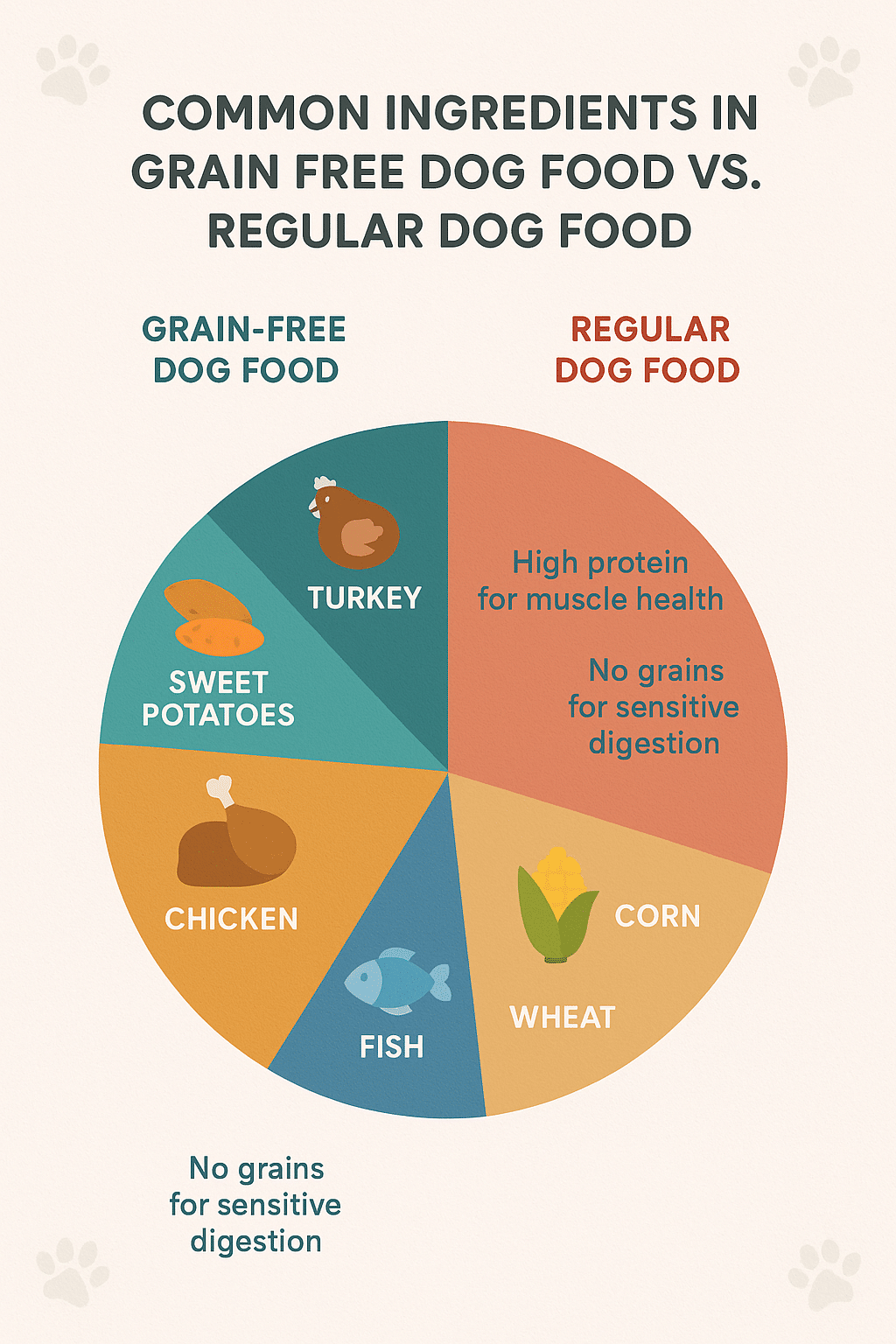
Defining Grain Free Dog Food and Common Ingredients
Grain free dog food is formulated without common grains like wheat, corn, barley, or rye. Instead, these foods often use alternative carbohydrate sources such as sweet potatoes, peas, lentils, or potatoes. The goal is to avoid ingredients that some dogs may find hard to digest or that may trigger allergies or sensitivities. But it’s important to clarify—“grain free” does not necessarily mean carbohydrate-free or low-carb. Many grain free foods replace grains with legumes and root vegetables that still provide energy.
Common ingredients in grain free formulas include:
- Protein sources: Real meat such as chicken, beef, bison, venison, or fish.
- Carbohydrates: Sweet potatoes, peas, potatoes, lentils, chickpeas.
- Fruits and vegetables: Blueberries, spinach, carrots, cranberries—packed with antioxidants and fiber.
- Healthy fats: Omega-3 and omega-6 fatty acids from fish oils and flaxseed.
- Added supplements: Glucosamine and chondroitin for joint support, taurine for heart health.
For example, Merrick Grain-Free Real Chicken & Sweet Potato Recipe uses real deboned chicken as its primary protein and sweet potato as a digestible carbohydrate source. Similarly, Natural Balance L.I.D. offers single-protein formulas that pair proteins like venison with sweet potatoes for a limited ingredient, grain free diet designed for sensitive dogs.
Grain Free vs Gluten Free: Clearing the Confusion
It’s easy to mix up grain free and gluten free dog food—they’re related but different. Gluten is a protein found primarily in wheat, barley, and rye. Some dogs may have gluten intolerance or allergies, which makes gluten free important. However, grain free excludes all grains—not just gluten-containing ones.
Dogs with gluten intolerance will benefit from gluten free food, which may or may not be grain free. Conversely, some grain free diets include legumes like peas or lentils that are gluten free but still carbohydrates—not grains.
In addition, choosing a grain free dog food removes all cereal grains, a common allergen for many dogs, regardless of gluten content. So, if your dog has digestive issues or allergy symptoms, knowing whether to focus on grain free or gluten free is key, and discussing with your vet can help clarify the best approach.
Health Considerations and Benefits of Grain Free Diets
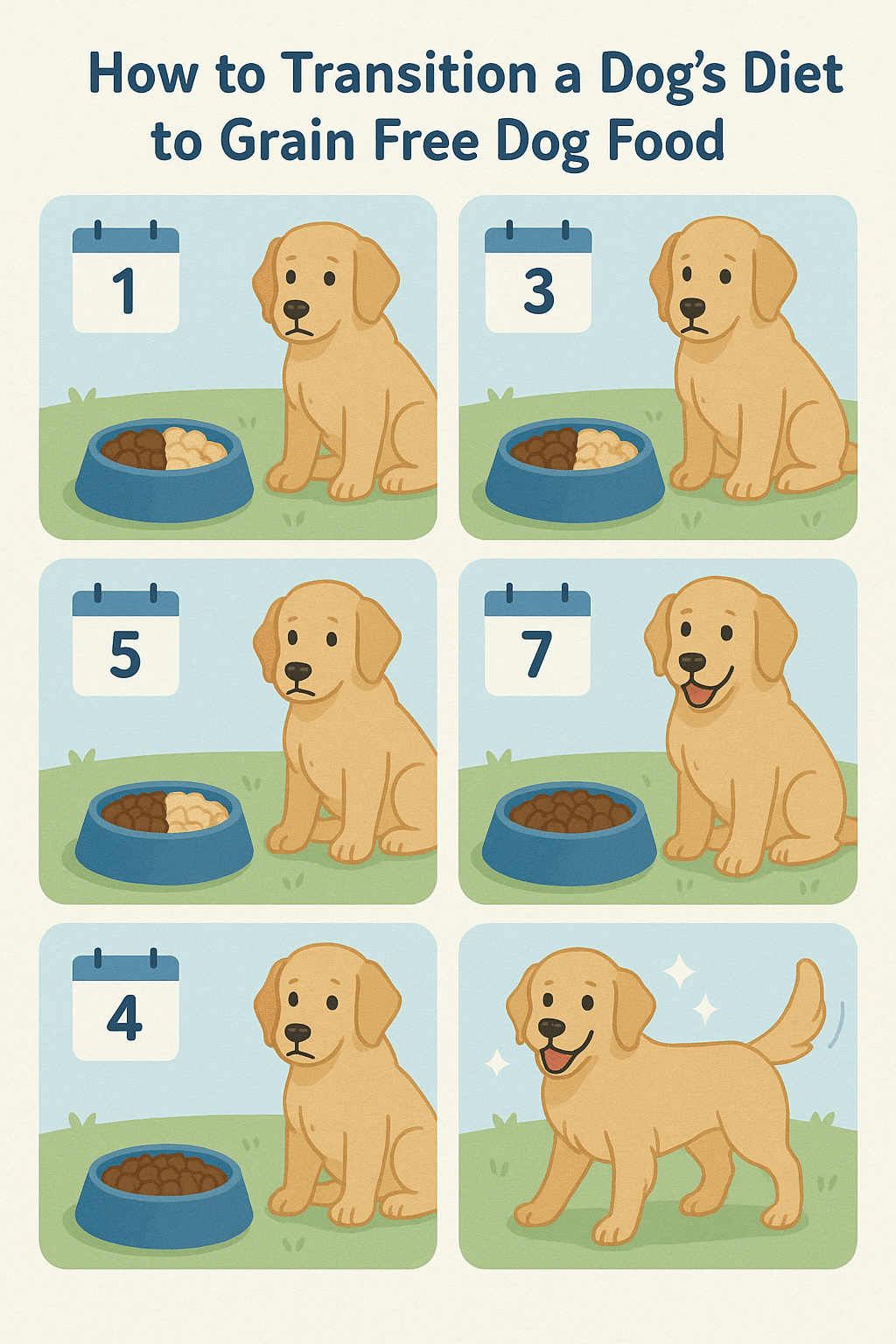
Dogs with Food Allergies and Sensitivities: When Grain Free Makes Sense
Many dogs suffer from food allergies and sensitivities, which can cause itchy skin, digestive upset, excessive shedding, or ear infections. Grain proteins like corn and wheat are common allergens in canine diets. Switching to a grain free dog food can reduce exposure to these allergens, potentially relieving symptoms.
Limited ingredient diets like Natural Balance L.I.D. and Canidae PURE Grain-Free Limited Ingredient Dry Dog Food help owners by offering formulations with minimal ingredients and single protein sources to narrow down triggers. For dogs with gluten intolerance, a grain free diet naturally excludes gluten.
However, not all dogs need grain free to avoid allergies. Some may react to other proteins or ingredients. The goal is to identify and eliminate the offending allergen, which may or may not be grains, so veterinary guidance and possibly allergy testing are recommended.
Is Grain Free Dog Food Safe for All Dogs? Risks and Myths
Despite their growing popularity, grain free diets are not necessarily suitable or needed for all dogs. Some pet nutrition experts caution that eliminating grains alone won’t solve every canine health problem and may introduce unintended consequences. For example, some grain free diets substitute peas and legumes as carbohydrate sources, which may cause allergy concerns in some dogs.
Additionally, grain free dog food is not inherently safer or better than grain-inclusive diets. Many dogs digest grains well, and whole grains provide fiber, B vitamins, and energy. Overemphasis on grain free as a catch-all health solution can mislead owners.
One myth is that grain free diets inherently cause heart disease; however, this concern is more complex and linked to specific ingredient formulations and the nutrient taurine, which some grain free foods may lack in adequate amounts.
The Controversy: Grain Free Diets and Dilated Cardiomyopathy (DCM) Risk
In recent years, the FDA investigated a possible link between grain free dog foods and dilated cardiomyopathy (DCM), a potentially fatal heart condition. This concern arose primarily in breeds not genetically predisposed to DCM and was linked to diets rich in peas, lentils, chickpeas, and other legumes.
While the investigation continues, vets recommend considering the overall nutritional balance, especially taurine levels, rather than solely the absence of grains. Some grain free diets like Natural Balance L.I.D. add taurine to support heart health. Feeding a high-quality, well-balanced grain free food under veterinary supervision remains safe for most dogs, especially when properly monitored.
How to Choose the Best Grain Free Dog Food for Your Pet
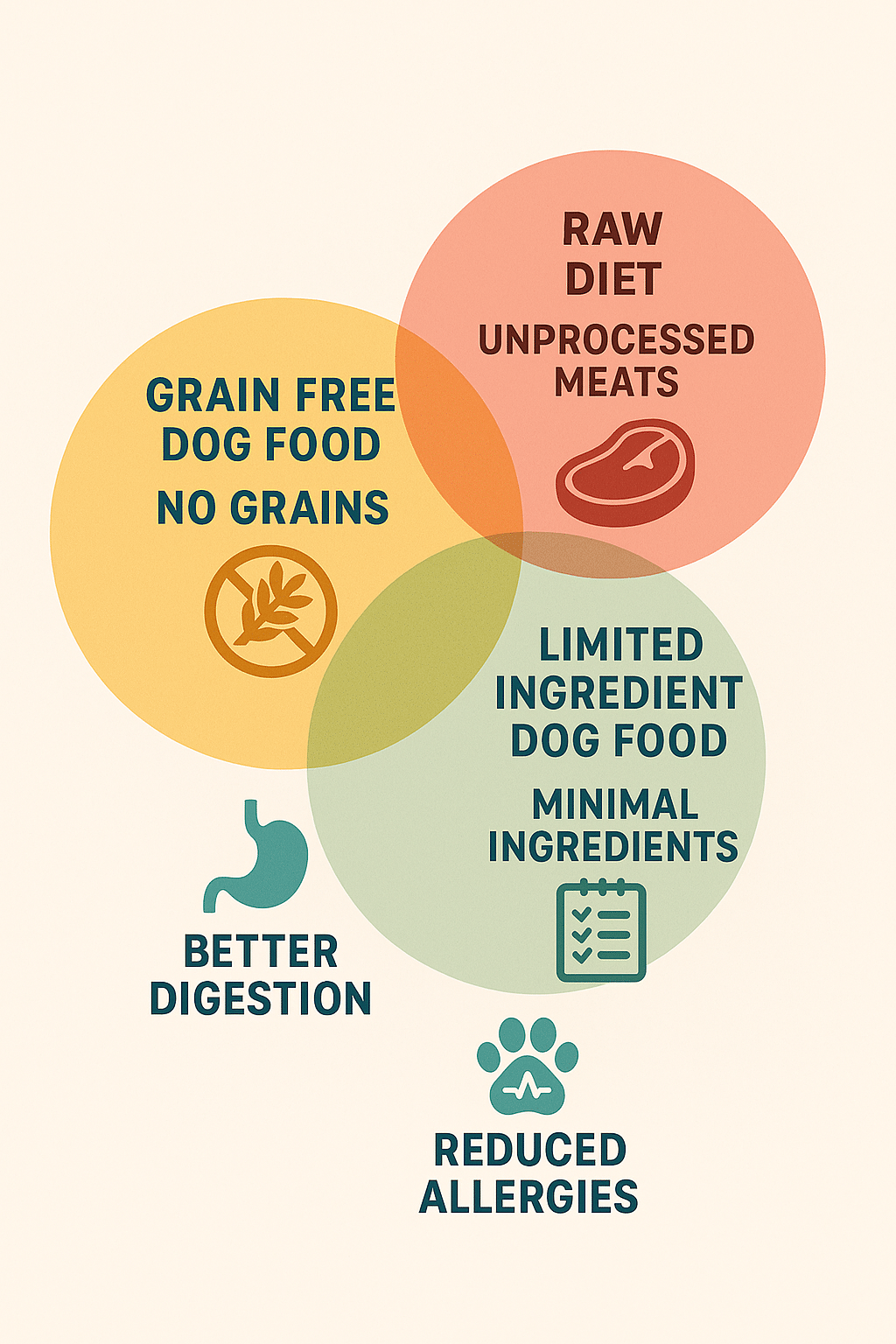
Evaluating Protein Sources and Nutritional Balance
When selecting grain free dog food, prioritize formulas that list real meat or fish as the first ingredient—it provides the essential amino acids for muscle development and maintenance your dog needs. Look for balanced amino acid profiles and adequate protein levels tailored for your dog’s life stage—puppies need more protein and fat than adult or senior dogs.
High protein grain free foods like Wellness CORE Grain-Free Original Formula and Taste of the Wild High Prairie Canine Recipe offer rich animal protein, with respectively 34% and 32% protein to support active or growing dogs.
A balanced nutritional profile is equally vital, including healthy fats such as omega-3 and omega-6 fatty acids, antioxidants for immune support, and fiber for digestive health. Avoid products with artificial preservatives, fillers, or low-quality ingredients like meat by-products.
Limited Ingredient Diets for Sensitive Dogs: Natural Balance L.I.D. and Canidae PURE
For dogs with multiple allergies or sensitivities, limited ingredient diets (L.I.D.) simplify nutrition to minimize allergen exposure. Natural Balance L.I.D. and Canidae PURE are top choices offering grain free limited ingredient diets with 10 ingredients or fewer.
These diets often use a single animal protein and one or two carbohydrate sources to minimize digestive upset and allergic reactions. For example, Canidae PURE offers Lamb and Sweet Potato or Salmon and Sweet Potato recipes that promote easy digestion while providing targeted nutrition.
L.I.D. diets make it easier for owners and vets to pinpoint allergens and improve overall tolerance, making them invaluable for dogs with complex dietary needs.
Key Nutrients to Look For: Omega Fatty Acids, Antioxidants, and More
Grain free dog foods should contain:
- Omega-3 and Omega-6 Fatty Acids: Important for skin, coat, and brain health. Sources include fish oil, flaxseed, and chia seeds.
- Antioxidants: Vitamins E, C, and natural fruits and veggies like blueberries protect cells from damage and support immunity.
- Taurine: A vital amino acid linked to heart health, especially relevant in grain free diets.
- Glucosamine & Chondroitin: For joint health and mobility in active or aging dogs.
- Fiber: From veggies or alternative carbs to maintain digestive health.
For instance, Nutro Ultra Grain-Free Adult Dry Dog Food includes a blend of 15 superfoods such as kale and blueberries, adding antioxidants beyond basic nutrition.
Transitioning Your Dog to a Grain Free Diet: Tips and Best Practices
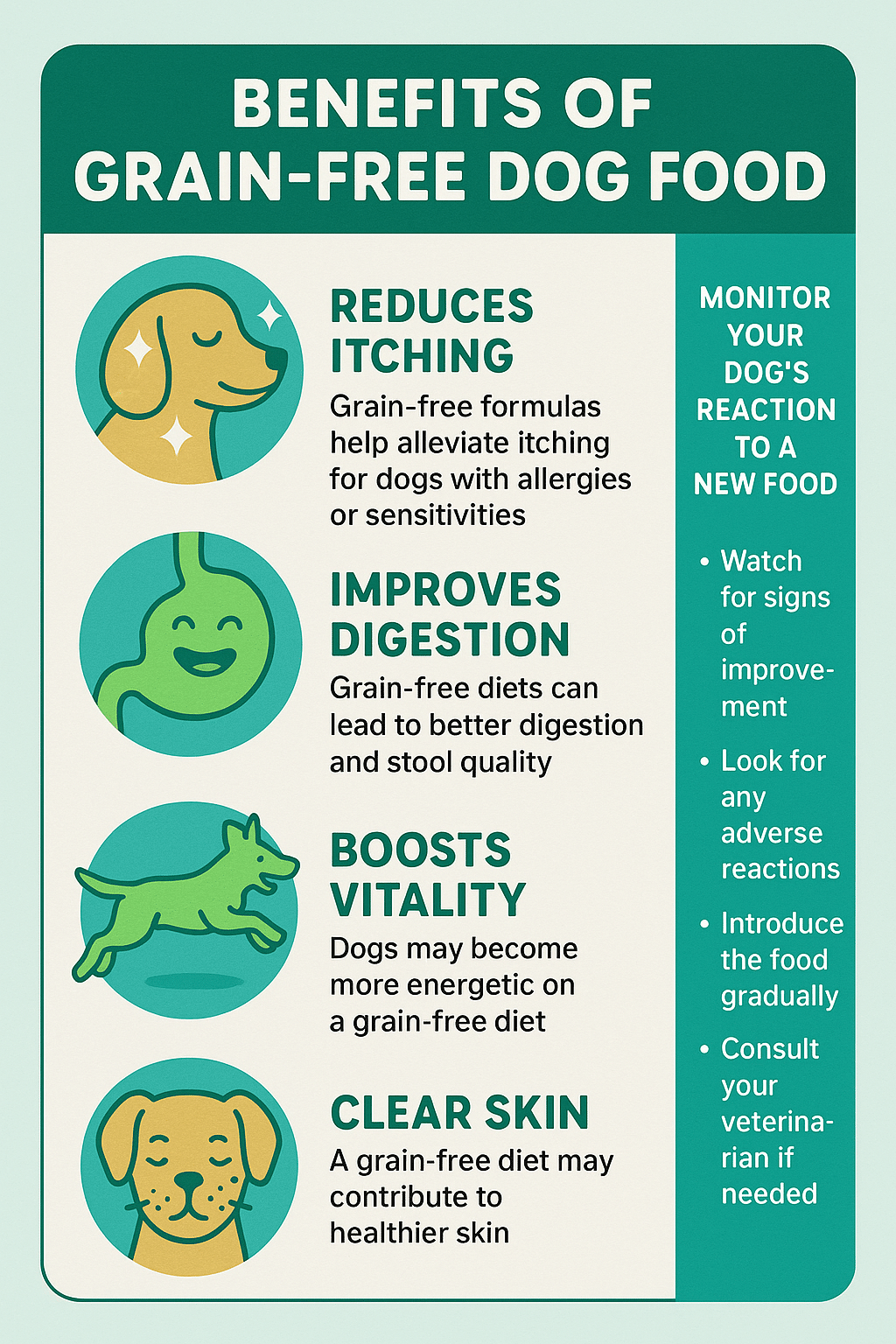
Gradual Transitioning to Prevent Digestive Upset
Switching your dog’s diet abruptly can cause vomiting, diarrhea, or loss of appetite. The best practice is a gradual transition over 7 to 10 days. Start by mixing 25% of the new grain free food with 75% of the old food. Slowly increase the new food ratio every 2-3 days until 100% grain free food is reached.
For limited ingredient diets, transitioning slowly also allows your dog’s digestive system to adjust without triggering sensitivities.
Monitoring Your Dog’s Digestive Health and Energy Levels
During and after the transition, watch for changes in stool quality, energy, coat condition, and overall behavior. A positive response includes firmer stool, more energy, reduced itching, or improved digestion. Negative signs could include lethargy, vomiting, diarrhea, or worsening skin issues.
If adverse symptoms occur, consult your veterinarian promptly. They can rule out allergies, nutrient deficiencies, or other health concerns.
Reviewing Top Grain Free Dog Food Brands and Products
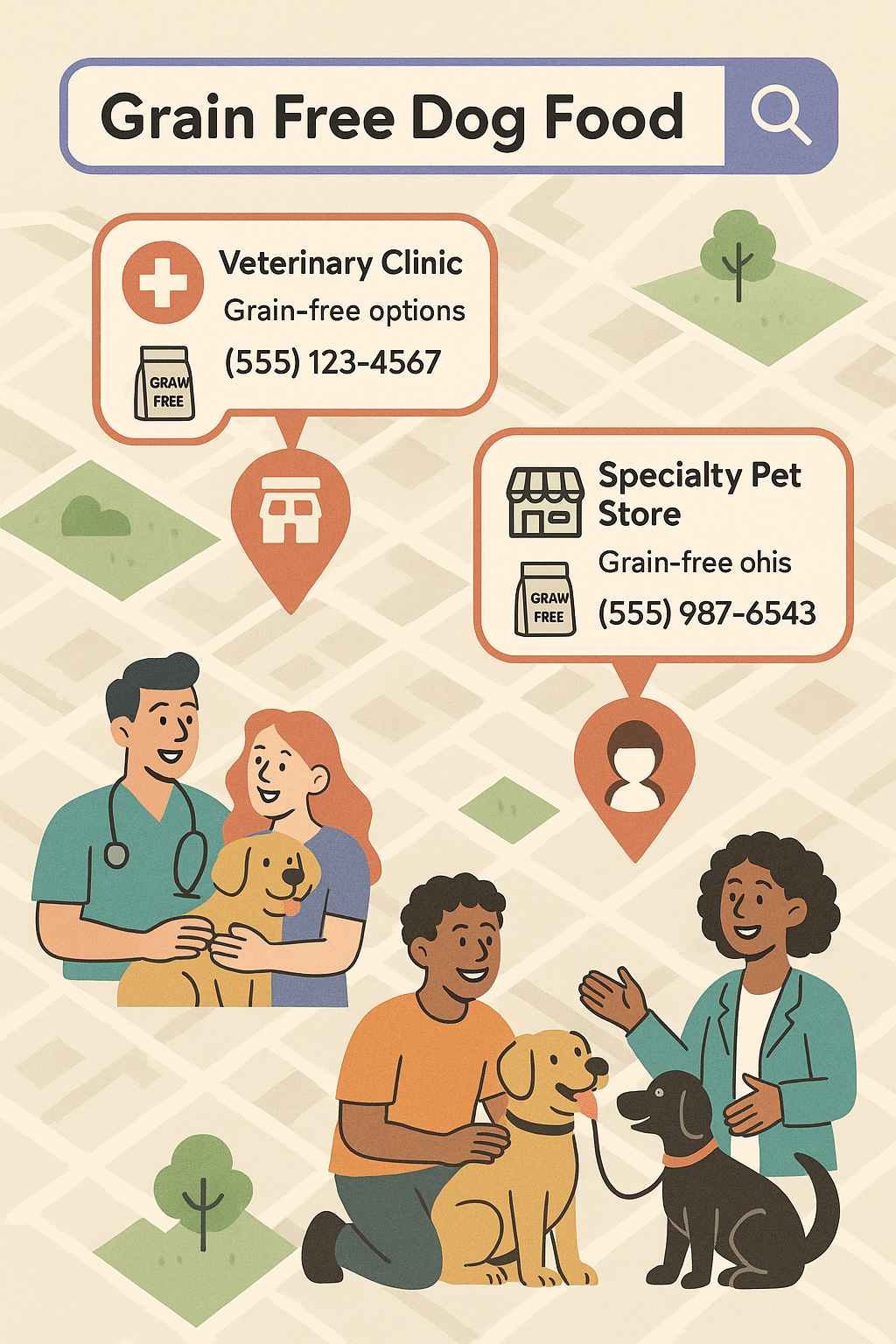
Blue Buffalo Freedom Grain-Free Adult Dog Food
- Features: Real meat first ingredient; grain free; antioxidant-rich fruits and veggies; omega fatty acids; no artificial additives.
- Use Case: Suitable for adult dogs needing grain free nutrition with balanced vitamins and minerals.
- Varieties: Beef, Lamb, Chicken flavors.
- Where to Buy: Available at PetSmart, Target, Petco.
- Pros: Trusted brand, variety of protein options, no grains or artificial stuff.
- Cons: Some dogs may react to pea protein used as a grain substitute.
Wellness CORE Grain-Free Original Formula
- Features: High protein (34%); no grains; natural ingredients; premium quality protein sources.
- Use Case: Active or working adult dogs needing high protein for energy.
- Where to Buy: PetSmart, Tractor Supply Co.
- Pros: Vet recommended; high protein; good digestibility.
- Cons: Pricier than some other brands.
Merrick Grain-Free Real Chicken & Sweet Potato Recipe
- Features: Deboned chicken first; sweet potato carbs; glucosamine & chondroitin; no corn/wheat/soy.
- Use Case: Adults with sensitivities needing premium protein and joint support.
- Where to Buy: PetSmart, North 40 Outfitters.
- Pros: Joint support ingredients; high-quality protein; grain free.
- Cons: Higher price point.
Nutro Ultra Grain-Free Adult Dry Dog Food
- Features: Real chicken, lamb, salmon protein trio; 15 superfoods; antioxidants; no artificial additives.
- Use Case: Owners looking for superfood-packed grain free diets for vitality.
- Where to Buy: PetSmart, Walmart.
- Pros: Broad nutrient profile; superfoods; multiple protein sources.
- Cons: Some dogs may prefer single protein limited diets.
Canidae PURE Grain-Free Limited Ingredient Dry Dog Food
- Features: 10 ingredients or fewer; single animal protein; probiotic support; grain free.
- Use Case: Sensitive dogs requiring simple, balanced grain free diets.
- Where to Buy: Canidae Official, Petco.
- Pros: Limited ingredients; great for allergies; probiotics included.
- Cons: Limited flavors.
Taste of the Wild Grain-Free High Prairie Canine Recipe
- Features: Roasted bison and venison; 32% protein; probiotics for digestion; antioxidants from fruits and veggies.
- Use Case: Dogs needing novel proteins and probiotic digestive support.
- Where to Buy: Taste of the Wild Official, Amazon.
- Pros: Unique novel proteins; high protein content; probiotics.
- Cons: Some dogs may be sensitive to legumes.
Where to Find Quality Grain Free Dog Food Locally and Online
Finding quality grain free dog food nearby is easier than ever thanks to specialty pet stores, big box retailers, and delivery options. Here are some places you can look:
- PetSmart: Offers a wide variety of grain free options including Blue Buffalo Freedom, Wellness CORE, Merrick, Nutro Ultra, and Canidae PURE.
- Petco: Stocks Natural Balance L.I.D., Canidae PURE, and Blue Buffalo Freedom.
- Local Pet Boutiques: Stores like The Hungry Puppy provide curated grain free dog food with personalized service.
- Online Retailers: Websites like Amazon, Chewy, and brand official stores offer home delivery with subscription options.
- Grocery and Department Stores: Target and Walmart carry popular grain free brands in-store and online.
- Delivery Platforms: Instacart, DoorDash, and Wag N Wash can bring grain free dog food right to your doorstep.
Check local availability as stocks and selections may vary by region and season.
Homemade and DIY Grain Free Dog Food: Pros, Cons, and Recipes
When to Consider Homemade Grain Free Diets for Your Dog
Homemade grain free dog food appeals to many owners seeking complete control over ingredients, avoiding preservatives and fillers found in commercial products. However, homemade diets require careful planning to meet all of your dog’s nutritional needs. Deficiencies or imbalances can lead to health issues.
Consult a veterinary nutritionist before switching to homemade food to ensure you create balanced meals for your dog’s specific life stage.
Simple Grain Free Dog Food Recipes Using Natural Ingredients
Here’s a straightforward recipe for a nutritious homemade grain free meal:
Ingredients:
- 2 pounds ground turkey or chicken
- 1 cup finely chopped carrots
- 1 cup sweet potato, cooked and mashed
- 1/2 cup peas (frozen or fresh)
- 1/2 cup cooked spinach
- 1 tablespoon fish oil (for omega-3)
- 1 teaspoon calcium supplement (e.g., powdered eggshells)
- 1 cup water or broth (low sodium)
Preparation:
- In a large skillet, cook the ground turkey thoroughly over medium heat until no longer pink.
- Steam or boil the diced carrots, sweet potato, peas, and spinach until tender.
- Mix all ingredients (meat, vegetables, fish oil, calcium) in a large bowl. Add water or broth to desired consistency.
- Allow to cool before serving.
Tips and Variations:
- Substitute ground beef or lamb for turkey.
- Add coconut oil for additional healthy fat.
- Rotate vegetables seasonally—broccoli, zucchini, or green beans work well.
- Prepare in bulk and refrigerate for up to 3 days or freeze in portions for up to 3 months.
Nutrition:
This recipe provides balanced protein, carbohydrates from vegetables, essential fats, fiber, vitamins, and minerals. Still, supplementation with a canine multivitamin is recommended if feeding homemade full-time.
Veterinary Perspectives and Nutritional Advice on Grain Free Dog Food
When Vets Recommend Grain Free Diets for Dogs
Veterinarians typically recommend grain free diets for dogs diagnosed with grain allergies, gluten intolerance, or irritable bowel syndrome triggered by grain products. Limited ingredient grain free diets are popular tools to identify and manage food sensitivities.
For dogs with heart conditions or genetic risk factors for DCM, vets stress choosing grain free diets supplemented with taurine and adhering strictly to balanced, vet-approved nutrition.
Consulting Your Veterinarian Before Switching Dog Foods
Before transitioning to grain free dog food, always discuss with your veterinarian. They can evaluate your dog’s health history, nutritional requirements, and possible allergy risks. Routine check-ups and monitoring will ensure your dog thrives on their new diet.
Your vet may suggest blood tests or food trials to pinpoint causes of health problems and tailor a safe, effective diet plan.
Unique Insight: The Role of Balanced Carbohydrates in Grain Free Dog Food
Understanding Alternative Carb Sources Like Sweet Potato, Peas, and Legumes
Grain free diets replace grains with carbohydrates from sources such as sweet potatoes, peas, lentils, and chickpeas. These alternatives provide energy, fiber, and nutrients. Sweet potatoes are highly digestible and rich in fiber, vitamins A and C, while peas and legumes add protein and B vitamins.
However, some concerns have surfaced about high levels of legumes and their effect on taurine metabolism, which may relate to DCM risk in some dogs. Balancing carbohydrate types and amounts in the diet is essential.
How Carb Quality Impacts Digestive Health and Energy in Dogs
A quality grain free dog food ensures carbohydrates support steady energy release without causing spikes in blood sugar or digestive disturbances. Complex carbs like sweet potatoes provide fiber to regulate gut health, whereas overuse of legumes may increase fermentable fibers causing gas or sensitivity in some dogs.
Choosing grain free foods with varied carb sources and probiotics, such as Taste of the Wild High Prairie, helps optimize digestive function and energy balance for overall wellbeing.
FAQs About Grain Free Dog Food for Pet Owners
Q1: Is grain free dog food better for dogs with sensitive stomachs?
Yes, grain free dog food often helps dogs with sensitive stomachs or food allergies by eliminating common grain allergens and using easily digestible carbs like sweet potatoes or peas.
Q2: How do I transition my dog to grain free food without digestive upset?
Transition gradually over 7-10 days by mixing increasing amounts of the new grain free food with the current diet to allow your dog’s system to adjust comfortably.
Q3: Are all grain free diets free from peas and legumes?
No, many grain free foods replace grains with peas, lentils, or chickpeas, which are legumes. If your dog is allergic or sensitive to legumes, look for formulas without them.
Q4: Can grain free dog food cause heart disease?
Some investigations have linked certain grain free diets high in legumes to dilated cardiomyopathy (DCM) in predisposed dogs. However, grain free food itself isn’t inherently harmful; balanced nutrition and taurine supplementation are critical.
Q5: Where can I buy high-quality grain free dog food locally?
Stores like PetSmart, Petco, and local pet boutiques often stock top grain free brands including Blue Buffalo Freedom, Wellness CORE, Merrick, and Natural Balance L.I.D. Many also offer online purchasing and delivery.
Quick Takeaways / Key Points
- Grain free dog food excludes common cereal grains but replaces them with alternative carbs like sweet potatoes and legumes.
- Grain free is beneficial for dogs with grain allergies, gluten intolerance, or sensitive stomachs.
- Not all dogs need grain free diets, and some grain free formulas may contain legumes that cause sensitivities.
- Beware myths about grain free diets causing heart disease; balance and taurine levels matter more.
- Limited ingredient diets like Natural Balance L.I.D. and Canidae PURE simplify nutrition for sensitive dogs.
- Transition gradually to grain free food to avoid digestive upset and monitor your dog’s response carefully.
- Top grain free products include Blue Buffalo Freedom, Wellness CORE, Merrick, Nutro Ultra, Canidae PURE, and Taste of the Wild.
- Consult your veterinarian before making dietary changes to ensure your dog’s health and nutrition needs are met.
Conclusion
Grain free dog food isn’t a one-size-fits-all solution, but when thoughtfully selected, it can offer tremendous benefits to dogs with allergies, sensitivities, or those simply needing high-quality nutrition. Understanding what grain free means, how to evaluate ingredient quality, and how to transition your dog smoothly are the pillars of making smart dietary choices.
By exploring trusted brands like Blue Buffalo Freedom, Wellness CORE, and Merrick alongside limited ingredient options such as Natural Balance L.I.D. and Canidae PURE, you have a range of excellent options to suit your dog’s unique health and taste preferences.
Remember, your veterinarian’s advice is invaluable in tailoring the ideal grain free diet and monitoring your pet’s wellbeing as you switch gears. With patience, care, and a mindful approach, you’ll help your dog thrive with a diet that’s not only grain free but nutrient-rich and wholesome too.
Ready to explore grain free dog food options for your four-legged friend? Start by evaluating your dog’s needs, chat with your vet, and consider trying one of the recommended brands to see the positive difference a grain free diet can make. Here’s to happy, healthy meals and wagging tails!

